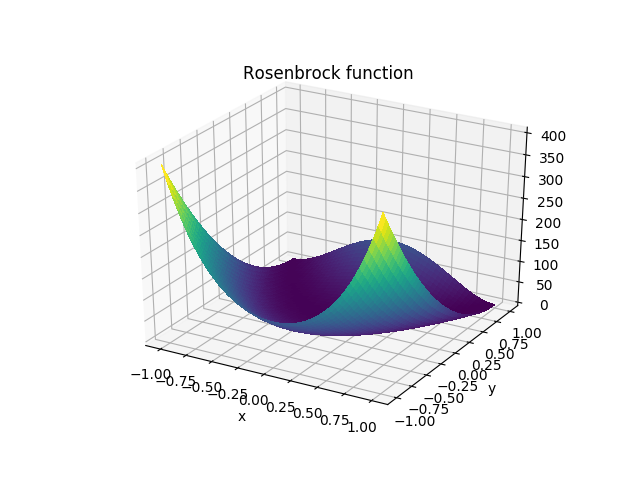Search
Week 8
Link to completed assignment
Problem 15.1
Problem 15.1
(a) The first thing we need to do is plot the Rosenbrock function, $$f = (1-x)^2 + 100(y-x^2)^2$$
import matplotlib
matplotlib.use('Agg')
import matplotlib.pyplot as plt
from mpl_toolkits import mplot3d
import numpy as np
def rosenbrock(x, y):
return ((1 - x)**2 + 100*(y - x**2)**2)
x = np.linspace(-1,1,1000)
y = np.linspace(-1,1,1000)
X, Y = np.meshgrid(x, y)
F = rosenbrock(X, Y)
fig = plt.figure()
ax = plt.axes(projection='3d')
ax.set_xlabel('x')
ax.set_ylabel('y')
ax.set_title('Rosenbrock function')
surf = ax.plot_surface(X, Y, F, cmap='viridis', linewidth=0, antialiased=False)
plt.savefig('./plots/search.png')

(b) Now, we will use the downhill simplex method to search for the function's minimum, starting from x = y = -1. Using the scipy.optimize.minimize function, we are able to determine the number of algorithm iterations and function evaluations used, as well as the final values of where the minimum is located.
import numpy as np
from scipy.optimize import minimize
def rosenbrock(x):
return ((1 - x[:-1])**2 + 100*(x[1:] - x[:-1]**2)**2)
x0 = np.array([-1, -1])
print(minimize(rosenbrock, x0, method='Nelder-Mead'))
| Algorithm iterations | 67 |
|---|---|
| Function evaluations | 125 |
| Final minimum location | (0.99999886, 0.99999542) |
(c) We will now repeat this process in 10D instead of 2D, using the following D-dimensional generalization of the Rosenbrock function: $$f = \sum_{i=1}^{D-1} (1-x_{i-1})^2 + 100(x_i - x_{i-1}^2)^2$$ Starting with all xi at -1, we will again count the algorithm iterations and function evaluations.
import numpy as np
from scipy.optimize import minimize
def rosenbrock(x):
d = len(x)
sum = 0
for i in range(d):
xi = x[i]
xprev = x[i-1]
new = (1-xprev)**2 + 100*(xi - xprev**2)**2
sum = sum + new
return sum
x0 = np.array([-1, -1, -1, -1, -1, -1, -1, -1, -1, -1])
print(minimize(rosenbrock, x0, method='Nelder-Mead'))
| Algorithm iterations | 1048 |
|---|---|
| Function evaluations | 1459 |
| Final minimum location | (0.01023648, 0.01024337, 0.01023174, 0.01019699, 0.01016837, 0.01022307, 0.01023505, 0.0102289 , 0.01024435, 0.01018521) |
(d) Now, we will repeat and compare the 2D and 10D Rosenbrock search with the conjugate gradient method.
(e) Now, we will repeat and compare the 2D and 10D Rosenbrock search with CMA-ES.
(f) Finally, we will explore how these algorithms perform in higher dimensions. We will specifically take a look at the D-dimensional generalization of the Rosenbrock function being evaluated by the Nelder-Mead method of various dimensions.
import numpy as np
from scipy.optimize import minimize
Dim_analysis = [2, 3, 4, 5, 10, 12, 15]
for D in Dim_analysis:
def rosenbrock(x):
d = len(x)
sum = 0
for i in range(d):
xi = x[i]
xprev = x[i-1]
new = (1-xprev)**2 + 100*(xi - xprev**2)**2
sum = sum + new
return sum
x0 = -1*np.ones(D)
print(minimize(rosenbrock, x0, method='Nelder-Mead'))
| Dimensions | 2 | 3 | 4 | 5 | 10 | 12 | 15 |
|---|---|---|---|---|---|---|---|
| Algorithm iterations | 40 | 86 | 134 | 180 | 1048 | 1789 | 2341 |
| Function evaluations | 70 | 151 | 229 | 301 | 1459 | 2401* | 3000* |
| *Maximum number of function evaluations was exceeded. | |||||||